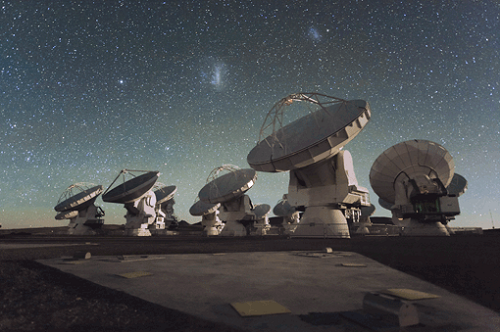HD 21997 is a star in the southern constellation Fornax (the Furnace) that is yielding some surprising data about how planetary systems form. About 235 light years from Earth, the star is 1.8 times the mass of the Sun and is thought to be about thirty million years old. Observations by an international team using ESA’s Herschel Space Observatory and the Atacama Large Millimeter/sub-millimeter Array (ALMA) in Chile show a ring of material around the star that contains not only a good deal of gas but also the dust produced by the collision of planetesimals.

Image: ALMA images of the disk around HD 21997. The left image shows the emission of cold dust grains, situated in a ring around the central star. The middle image displays the emission from carbon monoxide, and shows that gas can also be found closer to the star than dust. The right image depicts the velocity of the gas. The red-colored parts of the disk move away from us, while the blue-colored parts move towards us, indicating that the gas is rotating/orbiting around the central star. Credit: Á. Kóspál (ESA) and A. Moór (Konkoly Observatory).
This is an unusual finding because our models of planet formation predict that the primordial gas should be completely out of a young system after no more than ten million years, pulled into the star itself, or aiding in the formation of gas giant planets, with the balance simply dissipating because of intense radiation from the young star. But the disk around HD 21997 is obviously a hybrid, one that links the early and late phases of disk evolution. Moreover, the dust ring and the gas ring do not coincide. Ágnes Kóspál (ESA) sees this as a clue to how the two disks formed:
“The gas ring starts closer to the central star than the dust. If the dust and the gas had been produced by the same physical mechanism, namely by the erosion of planetesimals, we would have expected them to be at the same location. This is clearly not the case in the inner disk.”
The amount of gas is striking. The team’s data show that the total gas mass is somewhere between thirty and sixty times the mass of the Earth, an indication that the gas disk really is primordial material, as the amount of gas freed by collisions between planetesimals would be insufficient to explain this quantity. What’s ahead is a search for more systems like HD 21997 for further information about how our models of planet formation may need to be revised.
This is not the first time we’ve found indications of hybrid disks. In fact, disks around ? Pictoris, HD 32297, 49 Ceti, HD 172555, and HD 32297 are also known to contain small amounts of gas, a finding that has energized debate about whether the gas was produced by planetesimal collisions or was leftover material from the primordial disk. HD 21997 takes the debate to another level, because the amount of gas and the displacement of the two disks are strong indicators that the gas here is primordial, with all that implies about the need to adjust our models.

Image: Antennas of the Atacama Large Millimeter/submillimeter Array (ALMA), a compound telescope on the Chajnantor Plateau in the Chilean Andes. The final ALMA configuration has 66 antennas acting like a single telescope. Signals from this array made it possible to spatially resolve the emission of both the dust grains and the gas molecules. Credit: ESO/C. Malin.
The two papers on this work are Kóspál et al., “ALMA observations of the molecular gas in the debris disk of the 30 Myr old star HD 21997,” Astrophysical Journal Volume 776, Issue 2 (2013 – abstract) and Moór et al., “ALMA continuum observations of a 30 Myr old gaseous debris disk around HD 21997,” Astrophysical Journal Letters Volume 777, Issue 2 (2013 – abstract). See also this MPIA news release.



UA Astronomers Discover Planet That Shouldn’t Be There
By Vanessa Bailey/UA Dept. of Astronomy and Daniel Stolte/UANews,
December 5, 2013
The discovery of a giant planet orbiting its star at 650 times the average Earth-Sun distance has astronomers puzzled over how such a strange system came to be.
An international team of astronomers, led by a University of Arizona graduate student, has discovered the most distantly orbiting planet found to date around a single, sun-like star. It is the first exoplanet – a planet outside of our solar system – discovered at the UA.
Weighing in at 11 times Jupiter’s mass and orbiting its star at 650 times the average Earth-Sun distance, planet HD 106906 b is unlike anything in our own Solar System and throws a wrench in planet formation theories.
“This system is especially fascinating because no model of either planet or star formation fully explains what we see,” said Vanessa Bailey, who led the research. Bailey is a fifth-year graduate student in the UA’s Department of Astronomy.
Full article here:
http://uanews.org/story/ua-astronomers-discover-planet-that-shouldn-t-be-there